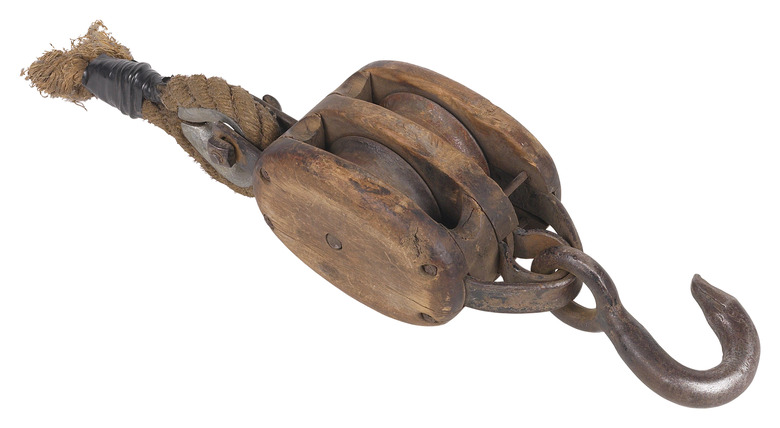What Is The Mechanical Advantage Of Single Movable Pulleys?
Pulleys are one of six types of simple machines, a device that allows people to accomplish work with less effort than the task would otherwise require. Simple machines allow this to happen due to their mechanical advantage, which provides a multiplier effect on the effort exerted. A moveable pulley is a type of pulley that moves with the object being moved.
Mechanical Advantage
Mechanical Advantage
Mechanical advantage is the name given to the force multiplier given by a simple machine. A machine's mechanical advantage is essentially a measure of how much the required force is spread throughout the machine. Mechanical is a force multiplier because it multiplies the amount of effort you exert. For example, if a box required 100 newtons of force to move it, and you attached it to a pulley with a mechanical advantage of 3, you would only need to apply 33 newtons of force, because 33 times 3 equals 99, which is close enough to 100.
Pulley
Pulley
All pulleys have two components: a rope and a grooved wheel. The rope fits around the wheel, allowing the rope to move around it. Pulleys are either fixed or moveable. A fixed pulley is stationary, attached to a wall or similar object. The weight moved by the pulley is attached to the rope. The wheel of a moveable pulley is not attached to any stationary object; one end of the rope is stationary instead. In a moveable pulley, the weight is attached to the wheel rather than the rope, and the wheel moves along the length of the rope as the weight is lifted or lowered.
Moveable Pulley
Moveable Pulley
The mechanical advantage of a moveable pulley is 2. This means that a moveable pulley will halve the required force needed to move any object attached to it. This occurs because in a moveable pulley one end of the rope is stationary, which means it absorbs some of the force needed to move the object. So, if you attach a 100 newton box to a moveable pulley, you will only need to apply 50 newtons of force to move the box because the moveable pulley will multiply your force by 2.
Advantage Calculation
Advantage Calculation
Pulleys work in tandem with each other, and adding pulleys will increase the mechanical advantage. Some sets of pulleys might include six or seven pulleys in total. In order to calculate the mechanical advantage of a pulley system, you can count the number of rope segments between the pulleys. If the free end is point down, do not include it in the total, but if it is pointing up, the same direction the weight will be moved, include that as well. The mechanical advantage of the pulley system will be the final number.
Cite This Article
MLA
Burke, Chris. "What Is The Mechanical Advantage Of Single Movable Pulleys?" sciencing.com, https://www.sciencing.com/mechanical-advantage-single-movable-pulleys-8713894/. 24 April 2017.
APA
Burke, Chris. (2017, April 24). What Is The Mechanical Advantage Of Single Movable Pulleys?. sciencing.com. Retrieved from https://www.sciencing.com/mechanical-advantage-single-movable-pulleys-8713894/
Chicago
Burke, Chris. What Is The Mechanical Advantage Of Single Movable Pulleys? last modified March 24, 2022. https://www.sciencing.com/mechanical-advantage-single-movable-pulleys-8713894/
